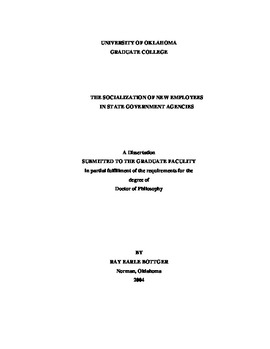| dc.contributor.advisor | James, Thomas E., | en_US |
| dc.contributor.author | Bottger, Ray Earle. | en_US |
| dc.date.accessioned | 2013-08-16T12:19:34Z | |
| dc.date.available | 2013-08-16T12:19:34Z | |
| dc.date.issued | 2004 | en_US |
| dc.identifier.uri | https://hdl.handle.net/11244/801 | |
| dc.description.abstract | The most important finding from the analysis of the relationship between the agency type, agency size, and employee type and the type of tactics used to socialize new employees is the disconnect between the types of tactics described by employees and the tactics the officials of the agency described in the interviews. | en_US |
| dc.description.abstract | Other findings from the analysis of the research's first relationship include: (1) Overall, mostly institutional tactics are being used to socialize new employees at state government agencies. (2) The main socialization process used by the agencies to socialize new employees is an orientation or intensive training for certain employees that substitutes for an orientation. (3) New staff employees are socialized using institutional tactics. (4) Management employees are being socialized using more individualized tactics than the new staff employees. (5) All agencies indicate that they would like to have employees that play custodial roles. (6) The two agencies that regulate personal behavior are the agencies that have no orientation for new employees and instead have intensive training for those employees that are enforcing regulations and no real socialization program for new management. | en_US |
| dc.description.abstract | Two relationships are examined in this research. First, the relationship between the agency type, the agency size, and the employee type and the type of tactics used by the agency is examined. Second, the relationship between the type of tactics used by the agency and the outcomes of the socialization process is examined. The second relationship partially replicates the research done by Jones (1986) in the private sector. | en_US |
| dc.description.abstract | Other findings from the analysis of the research's second relationship include: (1) Institutionalized socialization tactics are negatively related to role conflict and role ambiguity and positively related to commitment. (2) Investiture and serial methods are among the most important of the socialization tactics in mediating personal adjustments to organizations. (Abstract shortened by UMI.) | en_US |
| dc.description.abstract | Second, the analysis of the data from the new employee survey also indicates that the scales developed by Jones to measure the context variables did not replicate when a new employee receives a complex socialization that includes tactics from both ends of the continuum of the scale. | en_US |
| dc.description.abstract | There are two main findings from the analysis of the relationship between the type of tactics used by the agency and the outcomes of the socialization process. First, all of the analyses done on this relationship indicate a positive relationship between the new employee's motivation to serve the public and commitment to the organization. Thus, this research indicates that in addition to the tactics used to socialize new employees, public service motivation is a significant factor in predicting the outcomes of the socialization process in the public sector. | en_US |
| dc.format.extent | xx, 251 leaves : | en_US |
| dc.subject | Oklahoma Officials and employees Training of. | en_US |
| dc.subject | Employee orientation Oklahoma. | en_US |
| dc.subject | Political Science, Public Administration. | en_US |
| dc.subject | Organizational sociology. | en_US |
| dc.subject | Professional socialization Oklahoma. | en_US |
| dc.subject | Civil service Oklahoma Sociological aspects. | en_US |
| dc.subject | Sociology, Industrial and Labor Relations. | en_US |
| dc.title | The socialization of new employees in state government agencies. | en_US |
| dc.type | Thesis | en_US |
| dc.thesis.degree | Ph.D. | en_US |
| dc.thesis.degreeDiscipline | Department of Political Science | en_US |
| dc.note | Adviser: Thomas E. James. | en_US |
| dc.note | Source: Dissertation Abstracts International, Volume: 65-09, Section: A, page: 3558. | en_US |
| ou.identifier | (UMI)AAI3148887 | en_US |
| ou.group | College of Arts and Sciences::Department of Political Science | |
